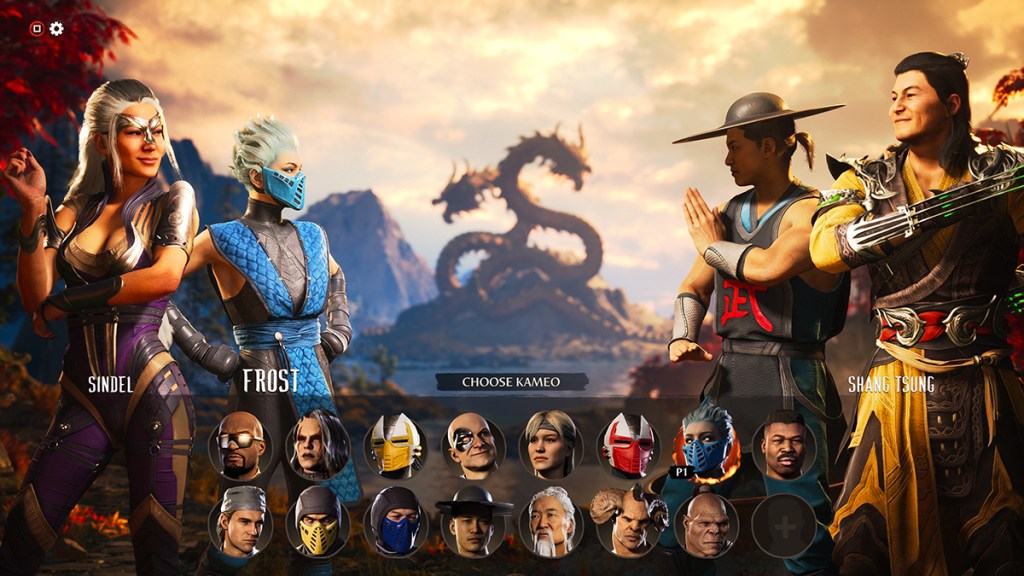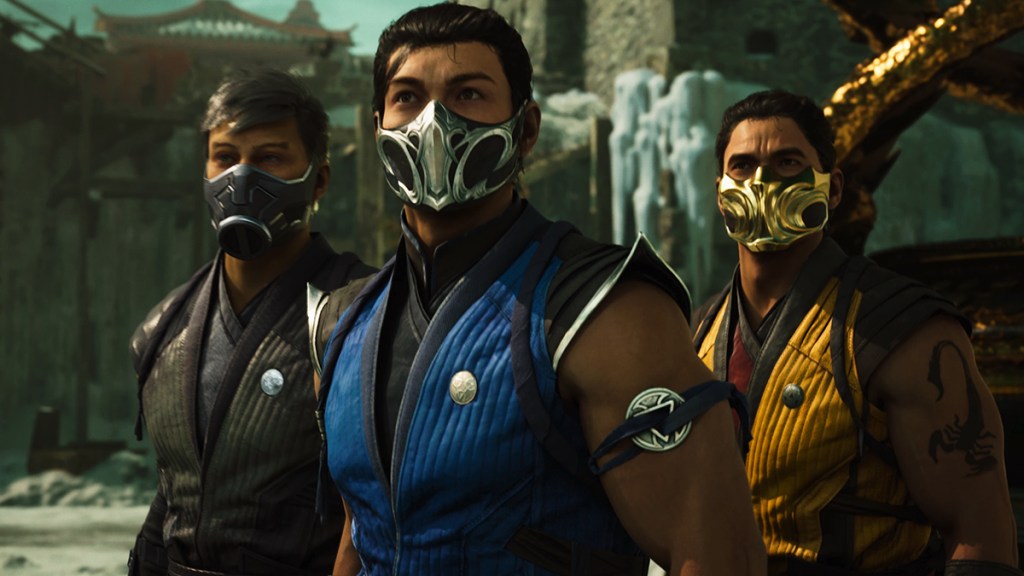Liu Kang has spent eons crafting timelines, taking lessons from one era and applying them to the next. All of his meticulous planning has resulted in a new era, one that bends previously sacred rules in order to lead to a better tomorrow. NetherRealm Studios’ journey mirrors Liu Kang’s, and while it didn’t take eons, the studio spent an unusually long time rebooting the Mortal Kombat universe for Mortal Kombat 1. These efforts to reshape the series have led to a more freeform gameplay style where creativity and player expression rule like an empress in Outworld. But such innovation has been paired with a surprising amount of stagnation elsewhere.
Stagnation began to define Mortal Kombat 11 in its later years, as its focus on neutral and slower play meant there were fewer ways to get creative. While it still held thrills, battles and combos could fall into a routine. Mortal Kombat 1’s fighting mechanics seem designed to address those shortcomings and are better for it.

Kameos are the clearest example of this newfound approach with the utility they bring to each match. These assists dip into some of the more obscure parts of Mortal Kombat lore — as evidenced by Darrius and Sareena — and have a handful of assists that add a whole new layer to combat. Some may extend combos, others help nullify projectiles, a few get players out of trouble, and a couple provide set play that can lead to some devious setups.
All of these variables open up possibilities and encourage players to experiment. Cyrax’s spin seems like a generic advancing attack, but it can be an excellent pressure tool. Jax’s unblockable ground pound initially looks like it’s just for catching the opponent off guard, but it’s got huge potential for nasty corner setups, especially for characters with air projectiles. This is particularly true with combos since small pop-ups that are otherwise useless can become extensive juggles with the right Kameo. Kameos add so many unique elements to fights that make Mortal Kombat 1 more dynamic.
The main roster has also been considerably expanded in order to match the newfound freedom given to it through its Kameos. Fighters across the board have been given more tools and meterless launchers; a fine byproduct of Mortal Kombat 1 not having to spread moves out over different variations. Characters have access to a wealth of new options and tricky tactics that make it more dynamic to watch and significantly raise the skill ceiling. Getting ruthlessly bounced around online (which has excellent netcode) is an inevitability and can seem unfair, yet it’s better than a game that prioritizes approachability over depth.
Mortal Kombat 1 hasn’t forsaken approachability; it just has an array of tools that have been redesigned or introduced to add more complexity for those who seek it. Flawless Blocks now just negate chip damage instead of leading to unearned combos. The new Up Block can now shut down predictable jump-in attacks and overheads. Fatal Blows have been reworked to include a cinematic prelude, which discourages thoughtless spamming since they’re easy to see coming. Meter management is also no longer automatic and is yet another system that can be exploited for an advantage. When these elements are combined with a more versatile cast and unique Kameo system, Mortal Kombat 1 ends up being a fighting game with an exciting future that seems destined to outlast its predecessors.

Many aspects outside of its core fighting mechanics aren’t quite as fresh. Invasion is the biggest solo-focused addition and is meant to take the place of the rotating towers that have been in the past three NetherRealm games (although those are still here, too). It plays out like a board game set in different Mortal Kombat locales where each node is a new fight. They’re often one round and have some sort of gimmick or modifier.
Invasion’s seasonal approach implies that it’ll be a constant source of new content, but it’s a stale mode at its core. Running through simple one-round fights with constant explosions distracts from the mechanics and doesn’t do anything interesting. NetherRealm has been doing this for four games and the novelty has worn off.

Invasion would have been better if the team innovated on what came before and created something that forced players to experiment with its systems. It could have acted as a subtle tutorial and gotten players to try out new characters and tactics. Instead, it’s a shallow campaign that just fills time. It even makes players worse at the game since it gets them to prioritize bad RPG mechanics and out-of-place Pokémon-like elemental weaknesses over techniques applicable to more competitive play.
The tutorials are generally thorough and can teach players the ropes, as they exhaustively walk through everything from fighting game fundamentals to more advanced systems. Concise explanations and guided demos are helpful, but making players actually complete these tasks a few times is the hands-on approach a great tutorial needs. It’s so helpful that it makes the lack of character-specific guides even more glaring. Injustice 2 and Mortal Kombat 11 had small tutorials for the whole roster that cleanly conveyed their strengths and weaknesses. With deeper fighters and an all-new Kameo system, Mortal Kombat 1 needed something like this to lower the barrier of entry and provide more clarity.

But this is just one of a few areas where Mortal Kombat 1 is strangely lacking when compared to its forebears. The unlock system is needlessly obtuse because it doesn’t list out what kind of gear is in the game or explain how to get any of it. Some of it is tied to each combatant’s individual level, but their battle pass-like tracks are shrouded in mystery for some reason. Towers also don’t list their spoils, killing the motivation to slog through them. Grinding for cosmetics makes for a solid loop, but not being able to see the rewards in the distance dampens the will to keep pushing. It’s not even clear how to unlock some of the Kameos, which shouldn’t even be locked in the first place.
The entertaining pre-battle banter has also been scaled back and mostly kept to local and unranked matches, robbing the game of some of its personality. Having fewer ways to hear silly exchanges and sick burns lessens the overall narrative presence since these back-and-forth taunts sometimes contained valuable bits of lore. It’s a waste to have them in there in some form but not put them in a majority of the modes.

Mortal Kombat 1 has more pressing narrative problems with its uneven story mode. NetherRealm has long since demonstrated its expertise making fighting game campaigns, and Mortal Kombat 1 lives up to those standards in many ways. Superb facial animations capture subtleties most games still can’t convey. Action scenes are expertly choreographed with incredible hit reactions and shot with wide angles that don’t obscure the kicks and punches. It’s easy to want to play fight scenes in a fighting game, but Mortal Kombat 1 makes watching them satisfying, too. The seamlessness from cutscenes to battles and vice versa is also still impressive and ensures that the pacing never slows down.
Most or all of that is true for NetherRealm’s gameography and, while familiar, the luster hasn’t faded much. The actual story is where Mortal Kombat 1 stumbles. Seeing a new take on established characters is exciting because most of these changes make for better drama. Witnessing Mileena’s humanity grounds her as a character. Making Sub-Zero and Scorpion brothers makes their conflict even more personal. Turning Baraka into a tragic figure screwed by fate is more nuanced than making him a bloodthirsty jobber. Even the fighters from the 3D era have been thoughtfully redesigned and utilize the team’s improved method of designing characters.
The story starts out promising as it reintroduces these fighters in their new roles. Fighting game stories typically suffer from trying to focus on too many faces at once — and this is no different — but the novelty that the reboot brings overcomes that genre-driven drawback. This fades in the latter half as the narrative balloons and starts revolving around a timeline-ending threat. Brisk pacing makes it easy to watch, but this means that it often falls back on magic to explain many important beats in order to save time. It’s a cheap crutch that hinders the last act and unexpectedly leads up to one of the campaign’s wildest moments. It doesn’t do the legwork to earn it, but it is still a goofy set piece that unexpectedly pays homage to one of Mortal Kombat’s most famous scenes.
Mortal Kombat 1 Review: Final Verdict
Mortal Kombat 1 has some of the most liberating combat mechanics NetherRealm has ever made, but some of the peripheral features fall a little short of what the studio has achieved prior. Being able to access more tricks and dig into the Kameo system gives fights more depth than they’ve ever had. That ingenuity clashes with the vague unlock system, repetitive Invasion mode, and inconsistent campaign that strangely don’t match the heights of previous NetherRealm games. Mortal Kombat 1 is a victory in many ways, just not a flawless one.
-
Fighters have more options and tools to play with
-
Kameo system further enhanced player freedom and experimentation
-
Visuals are stunning and the campaign benefits from its incredible presentation
-
Invasion mode is repetitive and counterproductive to learning the game
-
Unlock system is arbitrarily vague
Disclaimer: This Mortal Kombat 1 review is based on a PS5 copy provided by the publisher. Played on version 1.000.001.








